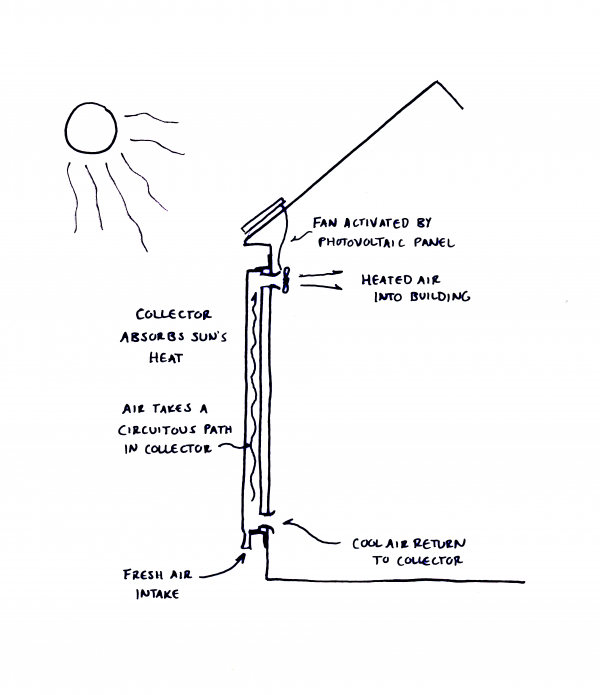Solar Hot air
HVAC: MATERIALS ENCYCLOPEDIA
Heat production & delivery
Solar heat production
Active or passive heat transfer
Passive or forced-air delivery
System components
Solar thermal collector (glazed or unglazed)
Ducting
Controls and fans, as required
How the system works

Solar radiation is collected in glazed or unglazed collectors in which air is heated in a plenum, often employing a circuitous or perforated pathway, and ducted into the building. Some systems use simple convection principles while others use a fan and ductwork to move air to a desired location in the building.
The air being heated in the panels can be fresh air from outdoors or recirculated indoor air. It is possible to create a system where the air source can be selected on demand. Heated outdoor air is likely to enter the building at lower temperatures than recirculated air, but can provide much-needed fresh air in a tightly closed home in the winter without adding any strain to the heating system.
Most systems are designed to be inexpensive and simple. Solar fraction may be relatively low, but so are cost and complication.
System output
There is a wide range of solar hot air collector designs, and output rates are highly variable.
Environmental impacts: Negligible
If solar energy is used to run any fans required, there will be no impacts from the operation of a solar hot air collector.
Material costs: low
The majority of hot air collectors are home made from simple and widely available materials. Manufactured systems will have high costs, but are still comparatively low in overall cost
Labor input: low to moderate
Systems and controls can vary in complexity.
Skill level required for the homeowner
Installation — Moderate. There are many types of DIY solar hot air panels that homeowners can build. Installing a pre-built unit requires fastening the collector to the building and creating a penetration in the building for the input tube.
Use — Easy.
Maintenance — Easy.
Sourcing/availability: Easy to moderate
There are many commercially available solar hot air systems. Most must be sourced directly from the manufacturer. A large percentage of solar hot air installations are homemade from widely available materials.
Code compliance
Solar air heating is not an accepted solution in most codes. It is likely to be accepted as an alternative solution if a licensed professional completes the design and any expected shortfall in heat output is addressed with a code-compliant backup system.
Durability: High
There are few or no moving parts in a solar hot air system, and they are typically very durable.
Indoor air quality: High
Solar hot air systems can be used to warm incoming fresh air during the winter, and can be an important part of a good ventilation system.
Whether a solar hot air system introduces fresh air or recirculates indoor air, it will move dust and allergens. Introduce a good filter into the system and clean it regularly.
Be sure to consider the types of materials — especially paints and caulking — used in solar hot air systems, as these can off-gas and be directed into the home.
Future development
The commercial development of solar hot air collectors is relatively recent and the systems are likely to improve dramatically in the coming decade. Though solar hot air cannot provide all the heat required for a building in most climates, the production of inexpensive, building-integrated collectors will make gaining this solar fraction easier and less expensive. With a lot of square footage of exterior surface area receiving sunlight, high fuel costs will make it practical to make the best advantage of this free heating input.
Resilience
Solar hot air technology can be constructed and used by an owner in a no- or low-energy scenario.
Tips for successful solar hot air
1. Solar hot air systems give reasonable returns when they are simple and low-cost. Avoid complexity and systems that will require maintenance.
2. Be sure that all penetrations made in the building enclosure during the installation are well sealed and that the system has some means of preventing thermosyphoning of heated indoor air to the outside when the collector is not producing heat. These kinds of losses could negate the heat gains from the collector.



